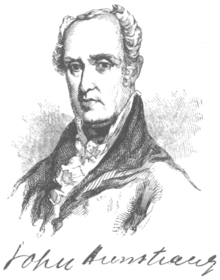John Armstrong Sr.
John Armstrong ( October 13, 1717 , † March 9, 1795 ) was an American civil engineer , major general in the American Revolutionary War and delegate from Pennsylvania to the Continental Congress .
Early years
Armstrong was born on October 13, 1717 in Brookeborough , County Fermanagh , Ireland to James Armstrong and Jane Campbell. He is a direct descendant of Johnnie Armstrong, a famous Scottish outlaw. John was raised in Ireland and became a civil engineer before emigrating to Pennsylvania. Armstrong came to Pennsylvania as a surveyor for the Penn family who owned the colony. In 1750 he drew up the first plan for the city of Carlisle, Pennsylvania and was one of its first settlers. He later became a land surveyor for the newly created Cumberland County .
Indian Wars
During the French and Indian War, attacked and plundered a combined force of Delaware / Lenape Indians and French in June 1756 Fort Granville (near present-day Lewistown ) and took a number of prisoners along the Kittanning Path on the way to their enhanced village Kittanning at the Allegheny River (now Kittanning, Pennsylvania ). Governor John Penn ordered provincial forces stationed in Cumberland County to respond. Colonel Armstrong led the Kittanning Campaign , a heavy attack deep into enemy territory that destroyed Kittanning on September 8, 1756. For this battle, Armstrong gained lifelong fame as the "Hero of Kittanning".
In 1758 Colonel Armstrong led Pennsylvania's 2,700 provincial troops on the Forbes campaign . The approach of these caused the French to evacuate and blow up Fort Duquesne.
During this campaign, Armstrong became a good friend of the other militia commander, Colonel George Washington .
American War of Independence
In the early stages of the American Revolutionary War, Armstrong was a brigadier general in the Pennsylvania Militia . On March 1, 1776, Congress appointed him Brigadier General of the Continental Army . He was then sent south to prepare for the defense of Charleston, South Carolina . His technical gifts helped build the defenses that enabled them to withstand the Siege of Charleston later that year . When General Charles Lee arrived to take command, he returned to his duties with the Main Army and the Pennsylvania Militia. Pennsylvania appointed him major general in charge of the state militia. This ended his service in the Continental Army, but not his service in the war or even his cooperation with General Washington.
At the Battle of Brandywine on September 11, 1777, Armstrong's militia held the left side of the American line. They were also responsible for protecting the army supplies. After a tough day of war, the Americans were forced to leave because they were surrounded. Armstrong got the supply train and its militia out of Pyle's Ford in the dark.
At the Battle of Germantown on October 2, General Armstrong led American command. His mission was to bypass the British left flank and attack their rear there. Despite the delay and difficulty some units had in advancing, the entire attack went well until the flank at Chew House was held.
Then a heavy fog came up, in which General Adam Stephen's men withdrew on Anthony Wyness's troops, which was probably also caused by friendly fire . Armstrong, whose men had advanced almost to the center of Germantown, were not greatly involved in the fight. He later complained that it was "a glorious victory, fought and an eight-tenth won, ... inexplicably lost, for this moment no man can ... give no valid reason for this escape."
After Germantown, Armstrong was granted permission to relinquish active command. His health - especially at sixty - was not what it had been, and old wounds gave him trouble. Returning home in Carlisle , he was elected to the Continental Congress by the Pennsylvania Convention. As a delegate between 1777 and 1780, he was a strong advocate of Washington and the standing army. Armstrong was a supporter of a new United States constitution. He returned to Congress during his final days between 1787 and 1788.
Later years
Armstrong served in a number of local civil offices throughout his life. One of these, the Carlisle school board , led to the initially rejected proposal of Dr. Benjamin Rush on the opening of a college in town. However, he later relented and became a member of the first panel of trustees at Dickinson College .
John died at home in Carlisle, Pennsylvania on March 9, 1795 and was buried in Old Carlisle Cemetery . In 1800, when Pennsylvania created a new county near Kittanning, it was named Armstrong County . His son, John Armstrong, Jr. also served in the Army and Congress, as well as a Senator from New York and Secretary of War of the United States.
Web links
- John Armstrong senior in the database of Find a Grave (English)
- John Armstrong senior in the Biographical Directory of the United States Congress (English)
| personal data | |
|---|---|
| SURNAME | Armstrong, John senior |
| ALTERNATIVE NAMES | Armstrong, John (maiden name) |
| BRIEF DESCRIPTION | American civil engineer, major general in the American Revolutionary War |
| DATE OF BIRTH | October 13, 1717 |
| PLACE OF BIRTH | Brookeborough |
| DATE OF DEATH | March 9, 1795 |
| Place of death | Carlisle, Pennsylvania |
